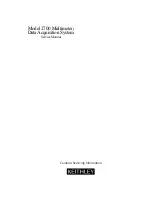
43
SENSe:VOLTage:DC:NPLCycles? [MINimum|MAXimum]
SENSe:CURRent:DC:NPLCycles {0.02|0.1|1|10|MINimum|MAXimum}
SENSe:CURRent:DC:NPLCycles? [MINimum|MAXimum]
SENSe:RESistance:NPLCycles {0.02|0.1|1|10|MINimum|MAXimum}
SENSe:RESistance:NPLCycles? [MINimum|MAXimum]
SENSe:FRESistance:NPLCycles {0.02|0.1|1|10|MINimum|MAXimum}
SENSe:FRESistance:NPLCycles? [MINimum|MAXimum]
For frequency and period measurements, aperture time (or gate time) is analogous to
integration time, and you can use the following commands to set it. Specify 10 ms (4 1/2
digits), 100 ms (default; 5 1/2 digits), or 1 second (6 1/2 digits).
SENSe:FREQuency:APERture {0.01|0.1|1|MINimum|MAXimum}
SENSe:FREQuency:APERture? [MINimum|MAXimum]
SENSe:PERiod:APERture {0.01|0.1|1|MINimum|MAXimum}
SENSe:PERiod:APERture? [MINimum|MAXimum]
3.1.8 Sensor Selection for Temperature Measurements
The multimeter supports both thermocouple and RTD. User needs to configure the
multimeter for the right sensor type before they can make temperature measurements.
RTD
Definition
If you are using RTD, the options are: PT100, D100, F100, PT385, PT3916, user-defined
RTD, NTCT and SPRTD. If you need to change the factors that are used to calculate the
temperature in RTD, choose user-defined RTD in which you are able to change any
factors as you wish. The default factors used are listed in
Table 4-3
:
Table 4-3
Type
Alpha
Beta
Delta
R-zero
PT100
0.003850
0.10863
1.49990
100Ω
D100
0.003920
0.10630
1.49710
100Ω
F100
0.003900
0.11000
1.49589
100Ω
PT385
0.003850
0.11100
1.50700
100Ω
PT3916
0.003916
0.11600
1.50594
100Ω
NTCT
0.003850
0.10863
1.49990
100Ω
Here is the temperature equation that is used to determine the RTD temperature:
Summary of Contents for DL-2060
Page 37: ...31 Figure 3 17 1 2 3 5 5 4...
Page 136: ...130...
Page 137: ...131...
Page 138: ...132 D DL 2060 s Dimension...
















































